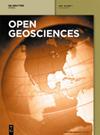应用遥感技术监测土地退化:斯坦纳里市(波斯尼亚和黑塞哥维那)案例研究
IF 1.7
4区 地球科学
Q3 GEOSCIENCES, MULTIDISCIPLINARY
引用次数: 0
摘要
研究课题是应用遥感技术监测波斯尼亚和黑塞哥维那(B&H)斯坦纳里市的土地退化情况。研究的目的是通过处理遥感 "产品",确定研究期间(2017-2023 年)的空间变化。在土地利用变化中,重点是地表矿产资源开采活动造成的变化。已批准的开采区总面积达 3841.08 公顷,几乎占该市面积的四分之一(23.89%)。通过使用监督分类(SC)处理哨兵-2 图像,对土地利用的变化进行了监测。分类结果与动态世界 (DW) 数据集进行了比较。结果表明,森林面积大幅减少,市级减少了-7.23%(DW)或-2.43%(SC),开发区域内减少了-11.48%(DW)或-5.90%(SC)。通过处理汉森全球森林数据变化数据集,确定并分析了毁林的空间范围。在研究期间(2001-2021 年),B&H 地区采矿活动造成的毁林面积达 977.94 公顷,其中 264.25 公顷(27.02%)位于斯坦纳里市。超过 90% 的开垦林区位于开采区内。在批准的开发区域内记录到了较高的侵蚀系数值 (Z),这与毁林的空间覆盖范围相吻合。此外,使用经验方法研究机械水侵蚀(W y)的结果表明,开采区内的侵蚀强度很高。对于已批准的开采区,对恢复退化土地的可能性进行了分析,包括概述迄今为止开展的活动和绘制一些先前开垦区域的地图。这项研究有助于更好地了解采矿活动造成的空间变化,所提供的数据对许多实际问题(如可持续土地利用规划、空间规划、森林生态系统保护和环境)具有重要意义。本文章由计算机程序翻译,如有差异,请以英文原文为准。
Application of remote sensing in monitoring land degradation: A case study of Stanari municipality (Bosnia and Herzegovina)
The subject of the research represents the application of remote sensing in monitoring land degradation in the municipality of Stanari in Bosnia and Herzegovina (B&H). The aim of the study is to identify spatial changes during the research period (2017–2023) by processing remote sensing “products.” Within the changes in land use, the focus is placed on alterations resulting from surface mineral resource mining activities. The total approved exploitation area amounts to 3841.08 ha, covering almost a quarter of the municipality (23.89%). Monitoring changes in land use was conducted through the processing of Sentinel-2 images using supervised classification (SC). The classification results were compared with the Dynamic World (DW) dataset. Results indicate significant losses in forested areas, reduced by −7.23% (DW) or −2.43% (SC) at the municipal level and −11.48% (DW) or −5.90% (SC) within the exploitation area. Spatial extents of deforestation were identified and analyzed based on processing the Hansen Global Forest Data Change dataset. The deforestation area, caused by mining activity in B&H over the research period (2001–2021), amounts to 977.94 ha, with 264.25 ha (27.02%) within the Stanari municipality. Over 90% of the cleared forest area is within the exploitation area. High erosion coefficient values (Z ) were recorded within the approved exploitation area, coinciding with the spatial coverage of deforestation. Additionally, results obtained using an empirical method for studying mechanical water erosion (W y ) indicate a high intensity within the exploitation area. For the approved exploitation area, possibilities for the restoration of degraded land were analyzed, including an overview of activities conducted so far and mapping some of the previously reclaimed areas. The research contributes to a better understanding of spatial changes resulting from mining activities, and the presented data are significant for numerous practical issues, such as sustainable land use planning, spatial planning, protection of forest ecosystems, and the environment.
求助全文
通过发布文献求助,成功后即可免费获取论文全文。
去求助
来源期刊

Open Geosciences
GEOSCIENCES, MULTIDISCIPLINARY-
CiteScore
3.10
自引率
10.00%
发文量
63
审稿时长
15 weeks
期刊介绍:
Open Geosciences (formerly Central European Journal of Geosciences - CEJG) is an open access, peer-reviewed journal publishing original research results from all fields of Earth Sciences such as: Atmospheric Sciences, Geology, Geophysics, Geography, Oceanography and Hydrology, Glaciology, Speleology, Volcanology, Soil Science, Palaeoecology, Geotourism, Geoinformatics, Geostatistics.
 求助内容:
求助内容: 应助结果提醒方式:
应助结果提醒方式:


